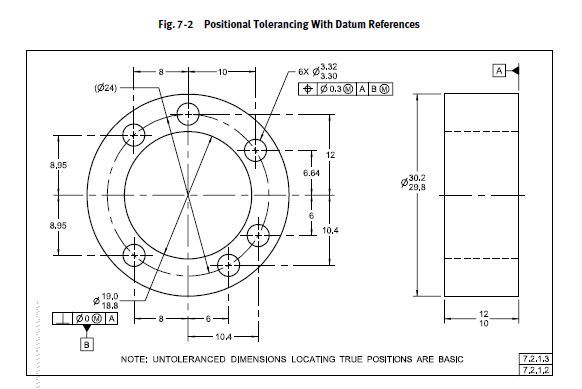Here are the main differences between position tolerances in two systems. I also added a little bit about coaxiality, concentricity and symmetry:
1. Type of features the position tolerance can be applied to:
- ASME - as already said, features of size only;
- ISO - as already said, features of size and nominally flat surfaces.
2. Shape of the tolerance zone when applied to a feature of size
- no significant difference between both standards.
3. Type of derived features controlled by the position tolerance when applied to a feature of size:
- ASME - position tolerance controls location of axis, center plane or center point derived from the unrelated actual mating envelope of the feature. Since by definition axis and center plane are perfect in form, position tolerance does not control any aspect of form of the considered feature of size;
- ISO - position tolerance controls location of extracted median line, extracted median surface or extracted (actual) center of the sphere. Since by definition extracted median line and extracted median surface are imperfect (here is the
link to a picture showing how the extracted median line of a cylinder is obtained), position tolerance has control over form of these derived features, thus over certain aspects of form of the feature of size.
4. Different possible interpretations of position tolerance applied to a feature of size:
- ASME - when applied at RFS position tolerance is interpreted in terms of axis of the feature. When applied at MMC and LMC it can be interpreted in terms of axis or in terms of surface (the draft of the future version of Y14.5 standard puts much more emphasis on surface interpretation being the "better" one for position at MMC and LMC).
- ISO - no difference for position tolerance applied at RFS, but when applied at MMC or LMC ISO standards use only the surface interpretation.
5. Coaxiality tolerance:
- ASME - coaxiality is nothing but position tolerance applied to nominally coaxial features of size. There is no extra symbol for that characteristic.
- ISO - coaxiality is also nothing but position tolerance applied to nominally coaxial features of size, but it has a separate symbol (the same as concentricity symbol in ASME).
6. Concentricity tolerance:
- ASME - this geometric characteristic has very special definition (control of feature of size's median points relative to datum axis), so it is never a special case of position.
- ISO - concentricity has the same symbol as coaxiality, but in addition the ACS modifier (Any Cross Section) is associated with the tolerance frame. This characteristic controls relationship between the toleranced feature and the datum feature in each cross section individually.
7. Symmetry tolerance:
- ASME - this geometric characteristic has very special definition (control of feature of size's median points relative to datum plane), so it is never a special case of position.
- ISO - symmetry tolerance has the same symbol as in ASME, but it is just a special case of ISO position applied to width-type features of size that are nominally in line with a datum.

![[smile] [smile] [smile]](/data/assets/smilies/smile.gif)

![[wink] [wink] [wink]](/data/assets/smilies/wink.gif)
![[bigsmile] [bigsmile] [bigsmile]](/data/assets/smilies/bigsmile.gif)